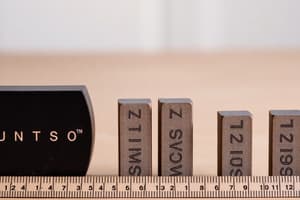Podcast
Questions and Answers
What is the SI unit for amount of substance?
What is the SI unit for amount of substance?
- Ampere (A)
- Kilogram (kg)
- Mole (mol) (correct)
- Kelvin (K)
What is the unit of force in the International System of Units (SI)?
What is the unit of force in the International System of Units (SI)?
- Kilogram (kg)
- Joule (J)
- Meter (m)
- Newton (N) (correct)
What is the graphical representation of velocity?
What is the graphical representation of velocity?
- Acceleration-Time Graph
- Position-Time Graph
- Velocity-Time Graph (correct)
- Jerk-Time Graph
What is the equation of motion for an object under uniform acceleration?
What is the equation of motion for an object under uniform acceleration?
What is the type of motion that occurs when an object moves along a circular path?
What is the type of motion that occurs when an object moves along a circular path?
What is the term for the rate of change of acceleration?
What is the term for the rate of change of acceleration?
Flashcards are hidden until you start studying
Study Notes
Measurements
- International System of Units (SI)
- Developed to provide a consistent and coherent system of units for physical quantities
- Based on seven base units:
- Meter (m) for length
- Kilogram (kg) for mass
- Second (s) for time
- Ampere (A) for electric current
- Kelvin (K) for thermodynamic temperature
- Mole (mol) for amount of substance
- Candela (cd) for luminous intensity
- Derived Units
- Formed by combining base units
- Examples:
- Velocity: m/s
- Acceleration: m/s^2
- Force: N (Newton) = kg·m/s^2
- Energy: J (Joule) = N·m
- Uncertainty and Significant Figures
- Measurements always have some degree of uncertainty
- Significant figures indicate the precision of a measurement
- Rules for significant figures:
- Non-zero digits and zeros between non-zero digits are significant
- Leading zeros and trailing zeros are not significant
Motion
- Describing Motion
- Displacement: Change in position, Δx = x_f - x_i
- Distance: Total length of path traveled
- Speed: Rate of distance traveled, v = Δx / Δt
- Velocity: Rate of displacement, v = Δx / Δt
- Types of Motion
- Rectilinear Motion: Motion along a straight line
- Circular Motion: Motion along a circular path
- Rotational Motion: Motion around a fixed axis
- Equations of Motion
- Uniform Acceleration: a = constant
- Equations:
- v = v0 + at
- x = x0 + v0t + (1/2)at^2
- v^2 = v0^2 + 2a(x - x0)
- Graphical Analysis
- Position-Time Graphs: Slope = velocity
- Velocity-Time Graphs: Slope = acceleration
- Acceleration-Time Graphs: Slope = jerk (rate of change of acceleration)
International System of Units (SI)
- Developed to provide a consistent and coherent system of units for physical quantities
- Based on seven base units:
- Meter (m) for length
- Kilogram (kg) for mass
- Second (s) for time
- Ampere (A) for electric current
- Kelvin (K) for thermodynamic temperature
- Mole (mol) for amount of substance
- Candela (cd) for luminous intensity
Derived Units
- Formed by combining base units
- Examples:
- Velocity: m/s
- Acceleration: m/s^2
- Force: N (Newton) = kg·m/s^2
- Energy: J (Joule) = N·m
Uncertainty and Significant Figures
- Measurements always have some degree of uncertainty
- Significant figures indicate the precision of a measurement
- Rules for significant figures:
- Non-zero digits and zeros between non-zero digits are significant
- Leading zeros and trailing zeros are not significant
Motion
Describing Motion
- Displacement: Change in position, Δx = x_f - x_i
- Distance: Total length of path traveled
- Speed: Rate of distance traveled, v = Δx / Δt
- Velocity: Rate of displacement, v = Δx / Δt
Types of Motion
- Rectilinear Motion: Motion along a straight line
- Circular Motion: Motion along a circular path
- Rotational Motion: Motion around a fixed axis
Equations of Motion
- Uniform Acceleration: a = constant
- Equations:
- v = v0 + at
- x = x0 + v0t + (1/2)at^2
- v^2 = v0^2 + 2a(x - x0)
Graphical Analysis
- Position-Time Graphs: Slope = velocity
- Velocity-Time Graphs: Slope = acceleration
- Acceleration-Time Graphs: Slope = jerk (rate of change of acceleration)
Studying That Suits You
Use AI to generate personalized quizzes and flashcards to suit your learning preferences.




